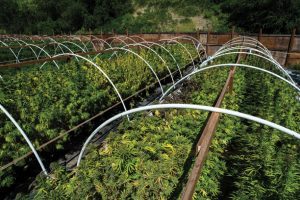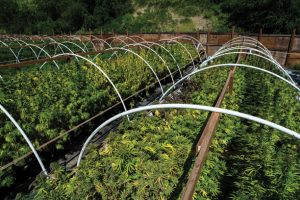Here in the Middle Rio Grande Valley, many outdoor gardeners are accustomed to a growing cycle that provides 7-8 months of production. Extending the growing season year around depends on both planting crops suited to cooler weather, and on providing some or total shelter for crops against damaging freeze. From large climate controlled greenhouses to pint-sized containers, there are many solutions for overcoming the rigors of harsh weather and reduced winter sunlight.
Lights can be strung up around fruit trees and left on during the coldest nights to protect the fruit. When temperatures would fall close to 0 degrees Fahrenheit during the coldest of winter nights, the lights would keep the fruit alive. Just that amount of climate control consistently provided the desired result, year after year. For garden beds however, the best solutions for year around production utilized structures providing a greater measure of climate control.
The most widely used structure by personal gardeners is the cold frame. The cold frame works by trapping heat to maintain a temperature plants may thrive in when it is cold outside. Designs for cold frames are numerous, but all share the same basic components. Four walls, from inches to stories high, and a translucent or transparent cover make a cold frame. The cold frame can be as easy as a one piece a plastic tub inverted over a garden bed. Here in the high desert a cold frame may yield edibles all year with little supplemental heat. When additional heat may be required for the coldest nights, solutions range from electric lights to flowing warm air or water.

Some gardeners find string lights ideal, with supplemental heat gained simply by plugging them in. Electric lights should be kept off the ground, and are best used in volumes of several cubic feet or more. Others find that using water heated by the daylight works well, discharging it’s heat throughout the night. Water can hold a great amount of heat, and is also ideal for small cold frames. Heated water circulated beneath a cold frame is also widely used, though primarily in larger structures like stadiums and commercial greenhouses. Another method for maintaining your garden’s microclimate is by circulating heated air. A heat source and fan are needed for this method. Some people use heat from their dryer, connected to their cold frame gardens, to maintain survivable temperatures. Necessity has driven ingenuity, and that has compelled varied and useful invention of practical solutions. With the availability of the Internet there are more ideas and solutions than you can shake a stick at. Cold frame construction plans, prebuilt cold frames, and ideas for maintaining climate conditions within cold frames are all available online en masse. Once a cold frame is in place, one need only decide what is best to plant inside. If you have several cold frames throughout the garden, you can encompass spices, ever bearing fruits, and other specific garden beds. Each cold frame will have it’s own needs for environmental control, but the similarities will be more than the differences.
In late winter to early spring, many summer crops can planted for a head start. You will notice that plants with a head start will tend to be the best and most prolific producers in the garden. In the late summer through fall the productivity of many crops can be extended in a cold frame, and through winter a variety of plants can continue to provide fresh nutrition to your daily nutrition. Fruits, vegetables and spices require varying measures of light and heat, so provide more light and heat in the fall and winter than what is naturally available. Don’t forget the about dormancy periods, with the sole exception of ever bearing fruits. Among the root, stem, and leaf vegetables are dozens that can readily be grown in cold frames through winter. From green manure crops to other more staple food and cold weather root, stem and leaf crops, harvests can be reaped for meals on almost any day.
Some cool weather vegetables include root crops, of which are the likes of carrots, beets, parsnips, green onions, potatoes and yams. Other cool weather vegetables include stem crops such as celery, asparagus, kohlrabi, leeks and rhubarb. Leafy cool weather crops include lettuces, spinach, parsley, cabbage, kale, collard greens and brussels sprouts. There are many other cool weather crops from around the world one can now import, so having a variety of vegetables to suit ones tastes is easier than ever. These will all do well in cold frames over the winter in the Southwest’s high desert.
As more people choose to benefit from the nutrient packed goodness of their own home grown vegetables, even more ideas will spring forth into the public domain to provide solutions to the challenges of year around gardening. As is, there are likely solutions to fit your needs. Grow well, see you in Spring!



















